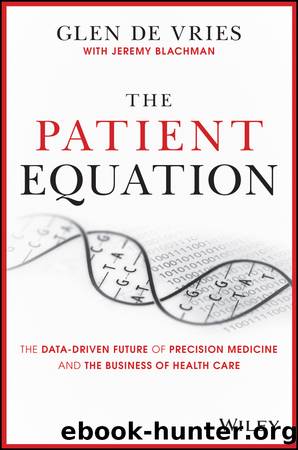The Patient Equation by Glen de Vries & Jeremy Blachman

Author:Glen de Vries & Jeremy Blachman [Vries, Glen De & Blachman, Jeremy]
Language: eng
Format: epub
ISBN: 9781119622277
Publisher: Wiley
Published: 2020-05-05T00:00:00+00:00
Something all Alzheimer's researchers would agree with is that effective treatment, to truly improve lives, typically starts way too late. We need to start as early as possible—ideally, even before we're able to detect the disease clinically. We can't do that now. A preclinical diagnosis isn't something that makes any sense in the health care world today. That's where patient equations come in.
We need to be able to predict who is going to cross that line—before it happens. This is where the genetic and molecular data merges with the phenotype information we talked about in the first section of the book, the cognitive and behavioral data that may—no, almost surely will—be able to sharpen the prediction we would otherwise make about who is going to need treatment for Alzheimer's disease.
The graph in Figure 9.4 obviously simplifies things. First, I've drawn the paths as straight lines, when we don't actually know what they look like, at least not yet. Maybe they're curves, or some other shape. And we also don't know to what extent they're fixed or malleable. Maybe they change—in direction or slope, like the dotted line D, where a patient takes an unexpected and potentially explainable turn for the worse—based on exercise, based on doing crossword puzzles, based on certain medications, based on any of those layers we've already discussed. We just don't know. But the lines are a starting point. And then, in Figure 9.5, there's me. I'm headed in some direction—with some velocity—toward both of the thresholds (dementia and death), and we need to figure out which line I'm set to cross first.
With more and more data—from sensors, from traditional measures, from everything we've talked about so far in this book—we can narrow that cone of prediction, and we can plot patients with more and more accuracy. And then we can try to do something to help the patients we see headed on that path toward the dotted dementia line. The cost of treating dementia, worldwide, has been estimated by the World Health Organization at $818 billion in 2015 alone4—imagine the societal impact and the savings for health care systems around the world if we could catch this disease just a little earlier, a little more reliably, with a little more time to treat, across populations. Mathematical models can be powerful things. It's not like we're going to see the future. But the models, as we feed them better and better data, can give us a better chance of picking the right therapy and of making smarter decisions about care.
Download
This site does not store any files on its server. We only index and link to content provided by other sites. Please contact the content providers to delete copyright contents if any and email us, we'll remove relevant links or contents immediately.
Good by S. Walden(2915)
The Social Psychology of Inequality by Unknown(2309)
0041152001443424520 .pdf by Unknown(2220)
The Checklist Manifesto by Atul Gawande(2202)
The Meaning of the Library by unknow(2068)
23:27 by H. L. Roberts(1891)
Guns, Germs and Steel by Diamond Jared(1883)
Being Mortal: Medicine and What Matters in the End by Atul Gawande(1805)
Borders by unknow(1785)
A Leg to Stand On by Oliver Sacks(1712)
The Hot Zone by Richard Preston(1632)
And the Band Played On by Randy Shilts(1615)
The Valachi Papers by Peter Maas(1516)
The Obesity Epidemic by Robyn Toomath(1420)
The Laws of Medicine by Siddhartha Mukherjee(1414)
The Andromeda Strain by Michael Crichton(1367)
The Plague and I by Betty Macdonald(1268)
Pharmacy Practice and The Law by Richard Abood(1254)
Autism's False Prophets by Paul A. Offit(1238)
